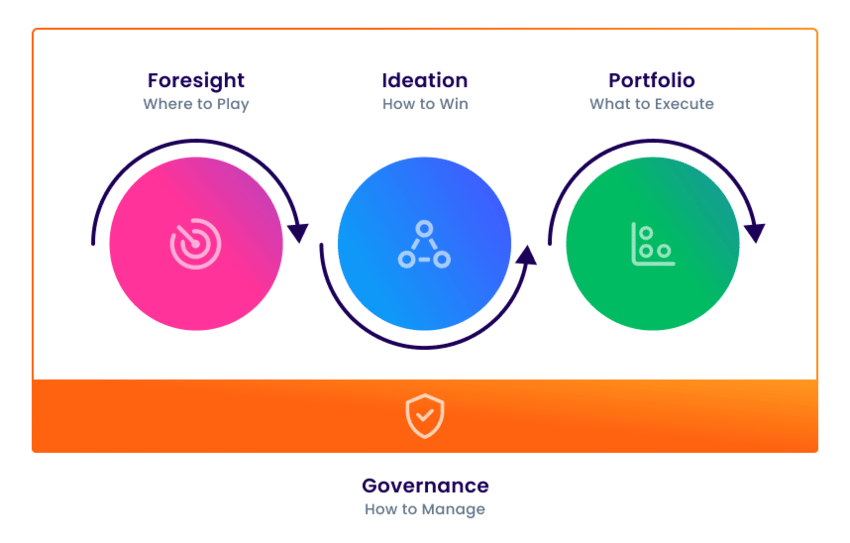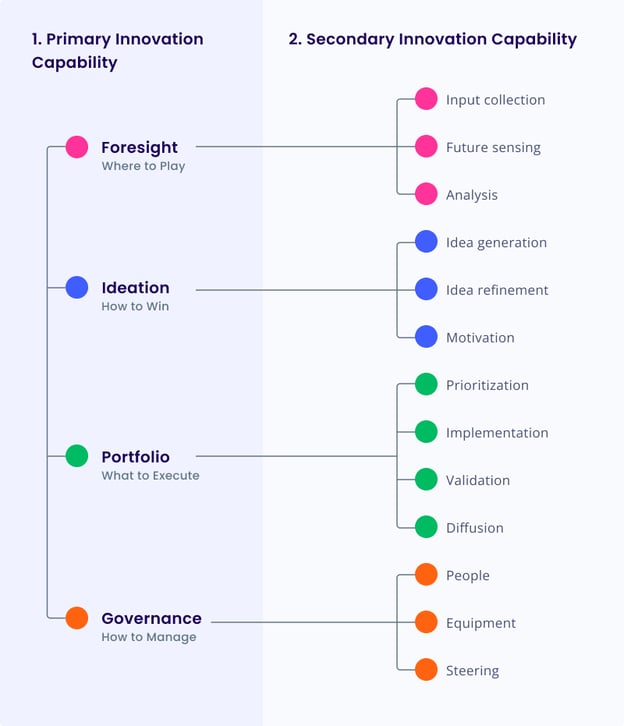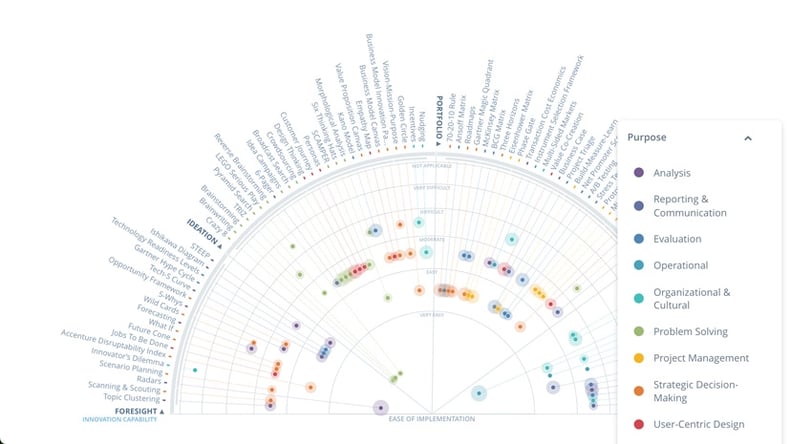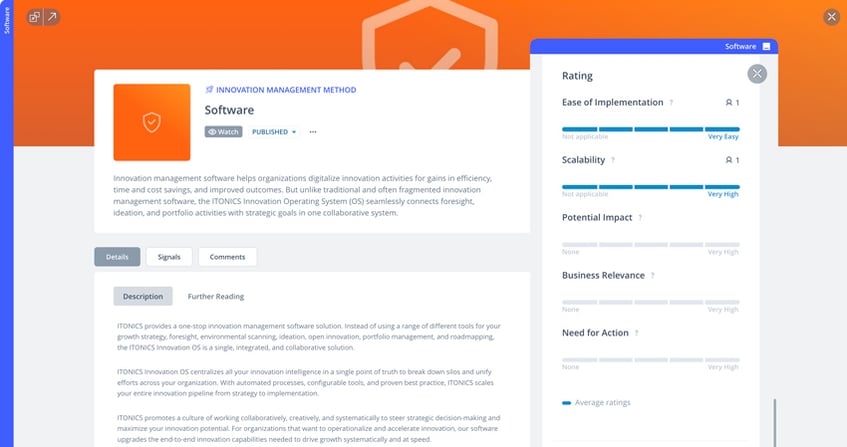The path to innovation excellence is paved with challenges and success hinges on more than just vision and innovative ideas—it requires a well-equipped toolbox of best-practice methods that span the end2end innovation process.
It is the responsibility of the Chief Innovation Officer to tailor their organization’s innovation toolbox, stocking it with the right set of methods, tools, techniques, and approaches that will work in combination to achieve their innovation goals.
In this blog, we outline the key considerations for Chief Innovation Officers as they select the innovation methods that will produce the most successful results for their organization. They must think about where in the innovation process the method will be applied, its intended purpose, and how well it aligns with organizational needs and structures.
Finally, we encourage readers to explore the full ITONICS Innovation Toolbox, which provides tips and resources for operationalizing these methods in your organization.
The role of a Chief Innovation Officer
The role of a Chief Innovation Officer (CINO) is to drive and oversee innovation initiatives within an organization. The CINO is responsible for developing and implementing strategies to foster innovation, create a culture of innovation, and ensure that the organization remains competitive and adaptable in a rapidly changing business environment.
Indeed, most CINOs have many responsibilities ranging from broad and functional to more granular and creative. One of these responsibilities is identifying and implementing the right innovation tools, techniques, and best-practice methodologies to support the innovation process.
This includes methods for various purposes, spanning different stages and steps within the innovation journey. CINOs must ensure that these tools are accessible and user-friendly for the innovation team. The outcome of these efforts is a fit-for-purpose, customized innovation toolbox containing all the methods needed for effective end-to-end innovation management.
Equipping innovation teams with the tools for success
Building a well-equipped innovation toolbox requires careful consideration of your organization's goals, the specific challenges you're addressing, the capabilities of your team, and the evolving business landscape. Making informed choices, given this context, can help companies improve innovation outcomes.
Research shows that Chief Innovation Officers who help their organizations create and maintain an advantage do so with a different and distinct set of innovation methods and tools compared to their more traditional peers (Harvard Business Review). It may come as no surprise that many of these methods are designed to manage uncertainty and have been popularized by startups, e.g. design thinking and the lean startup method
Beyond the actual makeup of your innovation toolbox, another important factor is where and how these methods are applied. For instance, idea generation and idea refinement methods can often be referred to and used interchangeably. However, they differ in their approaches and intended outputs. Idea generation is about creativity, exploration, and inspiration, while idea refinement is about practicality, prioritization, and implementation. Both are crucial in effective idea management but must occur at the right time within a structured framework (involving the right contributors and adequate feedback loops).
4-step guide for building your innovation toolbox
Chief Innovation Officers can use the ITONICS Innovation Toolbox as a starting point for determining the set of methods that are right for their team, use cases, and objectives. Each method is interlinked with solutions, templates, and best practices from the ITONICS Innovation OS to quickly put your innovation plans into practice.
What is the ITONICS Innovation Toolbox?
Configured on the Radar, the ITONICS Innovation Toolbox describes a comprehensive set of methodologies, tools, techniques, and concepts for organizations to operationalize end2end innovation, upgrade their innovation capabilities, and drive growth systematically.
Below, we outline four steps to help Chief Innovation Officers easily identify and implement the right innovation methods.
Step 1: What is the health of your end2end innovation process?
The first step in building your innovation toolbox is to understand the current structure, maturity, and performance of your organization’s end2end innovation process. This big picture assessment will help you identify where there are strengths or weaknesses in your innovation capabilities and where to support these capabilities with a diversified set of methods.
To get started, filter the methods in the ITONICS Innovation Toolbox by selecting the primary innovation capability you wish to augment. These capabilities are foresight, ideation, portfolio management, and governance.
Each capability poses a strategic question that organizations must address to move seamlessly from strategy to execution:
- Foresight answers where to play by identifying weak signals and understanding drivers of change to discover opportunities for growth and define an innovation strategy.
- Ideation answers how to win by unlocking collective intelligence and developing the right concepts to solve specific challenges.
- Portfolio management answers what to execute by prioritizing and balancing projects within an innovation portfolio to streamline delivery and ensure effective strategy realization.
- Governance answers how to manage, focusing on the overall framework, principles, and structures that guide, oversee, and control the innovation activities within an organization.
It is important to note that while foresight, ideation, and portfolio management comprise the primary steps within the end-to-end innovation process, orchestrating these steps effectively and amplifying their impact requires a clear innovation governance framework. Good governance enables accountability, transparency, engagement, and continuity in innovation.
1. Filter the method selection initially based on the primary innovation capabilities you aim to augment:

Find the primary innovation capabilities—foresight, ideation, portfolio, and governance—by looking at the segmentation on the Innovation Toolbox Radar.
Step 2: Where are there gaps in your innovation capabilities?
The next step in building your innovation toolbox is to identify specific gaps within your organization's primary innovation capabilities. These gaps may relate to the more granular or secondary capabilities—the steps, activities, skills, and organizational attributes and assets—that support your organization's innovation process.
After you’ve selected a primary innovation capability in step one, narrow down the selection of methods based on the secondary innovation capabilities you aim to facilitate. These could be areas where you feel you’re lacking capacity, want to improve outcomes, or explore a fresh approach.
2. Narrow down the method selection based on the secondary innovation capabilities you aim to facilitate:

Step 3: What purpose do you aim to achieve?
Now that you have identified the specific innovation capabilities around which you would like to build up your innovation toolbox, this third step requires you to consider the purpose of each innovation method. For instance, methods and tools associated with Portfolio > Implementation can serve different purposes ranging from project management and operations to evaluation and analysis.
While some methods may serve multiple purposes within your innovation process, identify the main purpose or intended outcome you aim to achieve by adopting a new or supplementing an existing innovation method.
3. Identify the innovation method(s) that align most closely with the purpose you aim to achieve:
- Analysis: Methods for gathering and interpreting data, trends, and insights to make informed decisions about potential opportunities, threats, and areas for improvement. Examples include: Tech-S Curve, Topic Clustering, SWOT Analysis, and Transaction Cost Economics.
- Evaluation: Methods for assessing the impact, relevance, and need for action of innovation assets like trends, ideas, projects, or new products, helping organizations prioritize their efforts. Examples include: Gartner Hype Cycle, Kano Model, BCG Matrix, and Minimum Viable Product.
- Operational: Methods for improving internal processes and workflows to enhance efficiency, reduce costs, and optimize resource utilization within an organization. Examples include: Full-Time Equivalent, Budget, and Instrument Selection Framework.
- Organizational & Cultural: Methods for fostering a culture of innovation within an organization, encouraging knowledge sharing and collaboration, and the development of an innovation mindset. Examples include: Innovators Dilemma, Incentives, Multi-Sided Markets, and Mendelow Stakeholder Matrix.
- Problem-Solving: Methods for facilitating creative thinking and idea development to address specific challenges or obstacles. Examples include: The Chasm, Brainstorming, Crowdsourcing, TRIZ, and Morphological Analysis.
- Project Management: Methods for planning, executing, and tracking the progress of innovation projects to ensure that initiatives are delivered effectively, efficiently, and consistently. Examples include: Phase Gate, Build-Measure-Learn, Product Life Cycle Model, Eisenhower Matrix.
- Reporting & Communication: Methods that enable organizations to effectively communicate innovation strategies, progress, and results both internally and externally. Examples include: Messaging Map, Business Case, Dashboards, and Reports.
- Strategic Decision-Making: Methods that support leaders in making critical choices related to innovation, often involving data-driven decision support. Examples include: Adoption Curve, Scenario Planning, Opportunity Framework, and Three Horizons.
- User-Centric Design: Methods for understanding and meeting the needs of end-users, including user research and usability testing to create products and services that resonate with customers. Examples include: Design Thinking, Personas, Value Co-Creation, and Empathy Map.

Step 4: What are your organizational needs and structure?
There is no one-size-fits-all when it comes to innovation methodology. Of course, similar principles can apply broadly, and many digital innovation tools allow for customization. However, just because you have identified an innovation method that supports your innovation capabilities and meets your intended purpose does not mean it is the right choice for your organization.
There are several other considerations that Chief Innovation Officers should take into account when building their team’s innovation toolbox. Innovation methods differ in complexity, cost, and return on effort. For instance, small innovation teams with few resources may be more suited to methods that are easy to implement, while scalability may be less of a priority for them. Building an innovation toolbox that is aligned with your specific organizational needs and structure ensures that innovation efforts are not only effective but also sustainable.
4. Assess and prioritize the innovation methods within the context of your organization by considering the following rating criteria:
- Ease of Implementation: How easy is it to implement or use this tool, considering inputs like effort, preparation, resources, and internal capabilities?
- Scalability: How scalable is this tool as you grow your innovation initiatives?
- Potential Impact: How high is the potential impact of using this tool within your organization?
- Business Relevance: How relevant is this tool to your organization?
- Need for Action: How important is it that your organization adopt this tool?

Putting your innovation toolbox into practice
Now that you have identified the innovation methods that align with your organization's goals, needs, and structure, it is time to apply them within your innovation process. How you apply the various methods will influence the acceptance and adoption rate within your organization as well as the outcomes.
Provide training and education to your teams on the selected methods, ensuring that everyone involved understands how to apply these methods effectively. Encourage teams to document their experiences and best practices when applying the various methods and share this feedback across the organization to promote learning and improvement.
Implementing innovation management software can help get your people on board and up to speed with your innovation methods. The ITONICS Innovation Operating System (OS) operationalizes end-to-end innovation methodology by providing configurable templates, customizable workflows, best-practice use cases, collaborative tools, and smart features. The Innovation OS scales easily from 10 to 10,000 innovators and will help you capture the greatest return on effort by centralizing all your foresight, ideation, and portfolio management activities on one collaborative platform.
To learn more about putting your innovation toolbox into practice and upgrading your innovation capabilities with the #1 Innovation OS, get in touch with our innovation experts for a free demo.




